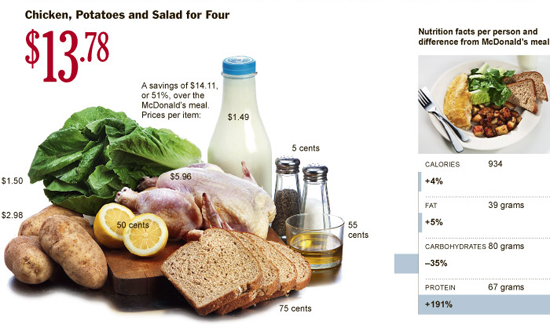
I’ve been a fan of Mark Bittman’s cooking and eating advice since I first saw his quirky, easy-to-follow “Minimalist” recipe videos for the New York Times. And he gained my admiration when he veered into the sustainability space with “Food Matters: A Guide to Conscious Eating,” his 2008 book that pushed low-on-the-food-chain seafood like squid and the good-for-the-planet-and-good-for-you dishes like oatmeal or rice and beans. But he really knocked it ouf the park with his latest column in the Sunday Times where he argues decisively, with nifty infographics, that good, healthy food can in fact be cheaper than the fast food alternative.
“I frequently read confident statements like, “when a bag of chips is cheaper than a head of broccoli …” or “it’s more affordable to feed a family of four at McDonald’s than to cook a healthy meal for them at home.”,” Bittman writes in “Is Junk Food Really Cheaper?” “This is plain wrong,” he contines, “In general, despite extensive government subsidies, hyperprocessed food remains more expensive than food cooked at home.” And this calculus doesn’t even include the national health bill consequences of bad eating. (Bittman’s Pollan-esque Ted talk from 2008 sums up some of what inspired his passionate plea for less meat, more veggies and paying greater attention to the global consequences of what we eat.)
So why don’t more people cook and eat good food? Bittman goes on to succinctly explain some of the cultural, ecological and socio-economic forces that keep us out of the kitchen and that make it hard to eat well: fast food is border-line addictive and heavily marketed, supermarkets are sometimes out of reach, many people think of cooking as a chore.
And then, playing the prolific cookbook-author, he lays out two simple meals–including chicken, potatoes and salad, and beans and rice–that feed a family better and cheaper than an equivalent meal at McDonald’s. (See the compelling multimedia comparison here.)
“In comparing prices of real food and junk food, I used supermarket ingredients,” he writes, “not the pricier organic or local food that many people would consider ideal. But food choices are not black and white; the alternative to fast food is not necessarily organic food, any more than the alternative to soda is Bordeaux.”
In fact, Slow Food USA’s recent “$5 Challenge” also elegantly turned the myth of cheap food on its head, as more than 30,000 Americans turned out to share homemade dishes constructed for less than 5 bucks. And many of these meals were made with local and organic ingredients procured from small farms. Smart-shopping can help even at “pricey” farmers markets or in the organic sections of grocers.
For my part, I would offer the following meal from the East End cooking cannon that would pass both the Slow Food and Bittman test for affordability, beating the McDonald’s meal on price and nutritional value (please excuse the round numbers, lack of cool illustrations, and allowance for homegrown produce):
– 2-3 dozen clams from the Sag Harbor farmers market, $10-15;
– one bag of whole wheat pasta, $5;
– one large head of broccoli (homegrown); farmstand bought would be $4;
– Parmesan cheese, salt, oil, and assorted condiments, including chili flakes and a splash of leftover white wine for the clams, $2.
Even at the upper limit of 3 dozen clams for a family of four, this meal of clams, pasta and broccoli, comes in nearly $2 under the McDonald’s meal. A hearty Bonac clam pie–clams, potatoes and onions baked in a pie crust–would probably pass this test too.
“Anything that you do that’s not fast food is terrific; cooking once a week is far better than not cooking at all,” Marion Nestle, professor of food studies at New York University, tells Bittman in the article. “It’s the same argument as exercise: more is better than less and some is a lot better than none.”
Bittman seems confident that once folks take a baby step towards such from-scratch solutions, that it will get easier and easier to break the fast food habit, while saving money and improving our health. “What’s easier is to cook at every opportunity, to demonstrate to family and neighbors that the real way is the better way,” he says praising the social joys of cooking together. “And even the more fun way: kind of like a carnival.”



